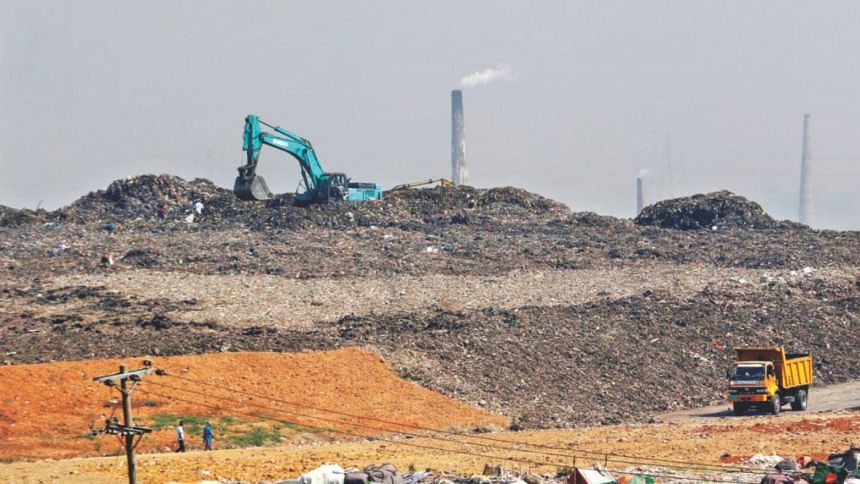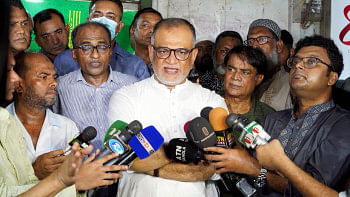When the garbage piles up

The near absence of an environment-friendly urban waste management system in Bangladesh is a major concern for the citizens. With the high rate of urbanisation in recent decades and the total urban population standing at 58 million today, the cities, Paurashavas and small urban centres produce a huge amount of solid waste every day. Besides urbanisation, improved living standards of the people and increased economic activities also resulted in a higher amount of waste per capita in the country. Bangladesh, the eighth most populous country in the world having 1,015 persons per sq. km of land area, is faced with an acute urban waste management problem. This is a threat to human health through pollution of surface and ground water, the soil and the air.
The solid waste generation in urban areas of Bangladesh amounts to around 25,000 tons per day, which translates into 170 kg per capita per year. The Dhaka city produces one-quarter of all urban waste in the country. The total urban solid waste is projected to grow up to 47,000 tons per day by 2025, due to the growth of population and increase in per capita waste generation. In 1995, per person average generation of urban solid waste was 0.49 kg/person/day but this amount is expected to increase to 0.60 kg/person/day by 2025. Data on waste collection efficiency in different urban areas varies from 37 percent to 77 percent, with an average of 55 percent.
Solid waste includes everyday items that are discarded by the public. The waste comes from residential, commercial, institutional, and industrial sources. The type of urban waste has been changing over time as plastic and polyethylene goods are increasingly thrown away by people affecting the environment and clogging the drainage system. In Dhaka city alone, millions of bags are dumped every day and a big part of that go into the drains, lakes and rivers. Again, hospital and clinical waste contains toxic chemicals, radioactive elements and pathological substances. 15 to 20 percent of medical waste is highly dangerous for human lives. In Dhaka and other major cities, medical waste is collected by the City Corporations from hospitals and clinics. A study of data on urban solid waste generation for two years, 2004 and 2014, shows a huge increase in the volume of waste generated within a period of only one decade. This clearly shows how the challenge of urban solid waste collection and disposal is growing over time.
Urban local bodies (City Corporations and Paurashavas) are responsible for hygienic disposal and management of waste within their jurisdictions. The primary collection of solid waste from households and markets in large cities is carried out through small neighbourhood efforts. In most cities, a door-to-door collection system is practiced with the effort of community leaders while in smaller ones, the Paurashava staff collect domestic waste and empty them into the community bins. People who collect the garbage take small amounts of money from the residents and shop-keepers for collecting and dumping them in the waste bins. The City Corporation and Paurashava trucks collect the garbage from the bins and take those to the landfill sites, which are open areas in the vicinity of the cities and towns. Segregation of garbage is not done by the local bodies and poor scavengers do it only for their own earning, except in some cities and towns where small pilot projects are being tested with the cooperation of donors and NGOs.
In general, the waste collection situation is not satisfactory and a huge amount of waste remains uncollected. The organic component of uncollected garbage pollutes the soil, water and air and badly impacts the local environment. Large quantities of solid waste also end up in the drainage system, blocking it and causing water stagnation after each rainfall. Again, a huge amount of solid waste goes into the water bodies, rivers and lakes and pollutes the water.
Some selected efforts to improve waste management are being experimented in Dhaka and other cities with support from the Japan International Cooperation Agency (JICA). Other initiatives are underway with Waste Concern, UNICEF, UNDP and NGOs like BRAC which are not, of course, adequate. The huge amount of urban waste generated can potentially be recycled into fertilisers, and generate electricity, and the recovered plastics and metals can be processed and used to produce new products.
The UN's Sustainable Development Goal 11 requires us to "make cities inclusive, safe, resilient and sustainable." Safe waste disposal is one of the major areas requiring significant improvements in order to achieve this goal. The urban local bodies need to design proper waste disposal methods and invest adequately in the next decade to achieve the 2030 Agenda for Sustainable Development. The City Corporations and Paurashavas should take this issue very seriously and strengthen operational procedures, adopt innovative technologies and involve local communities, NGOs and private sector in proper solid waste management. As a first step, the local bodies should go for safe disposal of waste in protected landfill areas to minimise the pollution of surface and ground water, soil and air. Gradually, they should move towards recycling, reuse and incineration methods and help improve the urban environment.
Dr Nawshad Ahmed is an economist and urban planner. He worked as a UN official in Bangladesh and abroad.

 For all latest news, follow The Daily Star's Google News channel.
For all latest news, follow The Daily Star's Google News channel. 



Comments